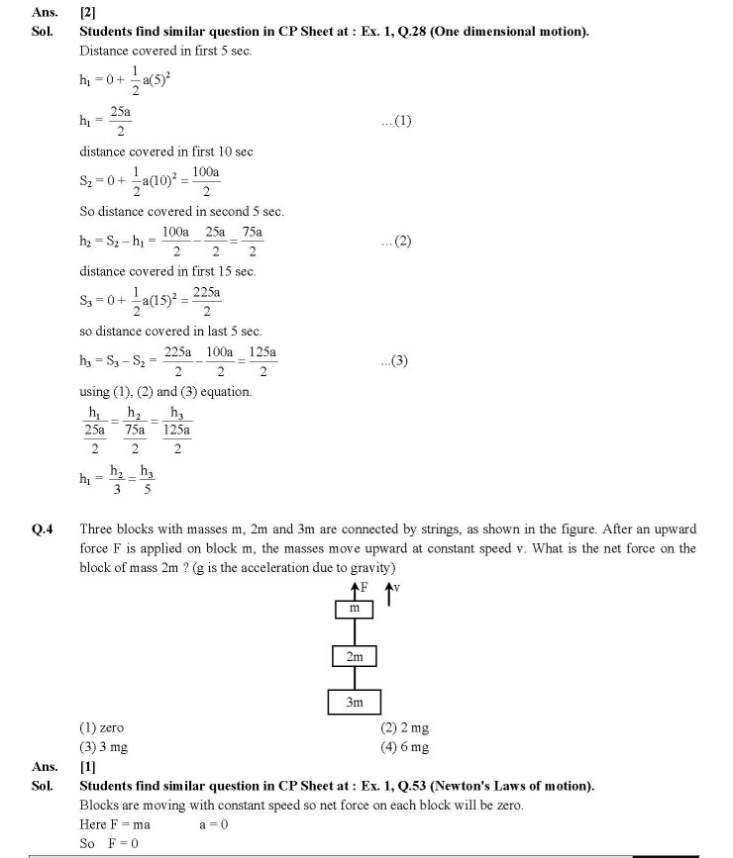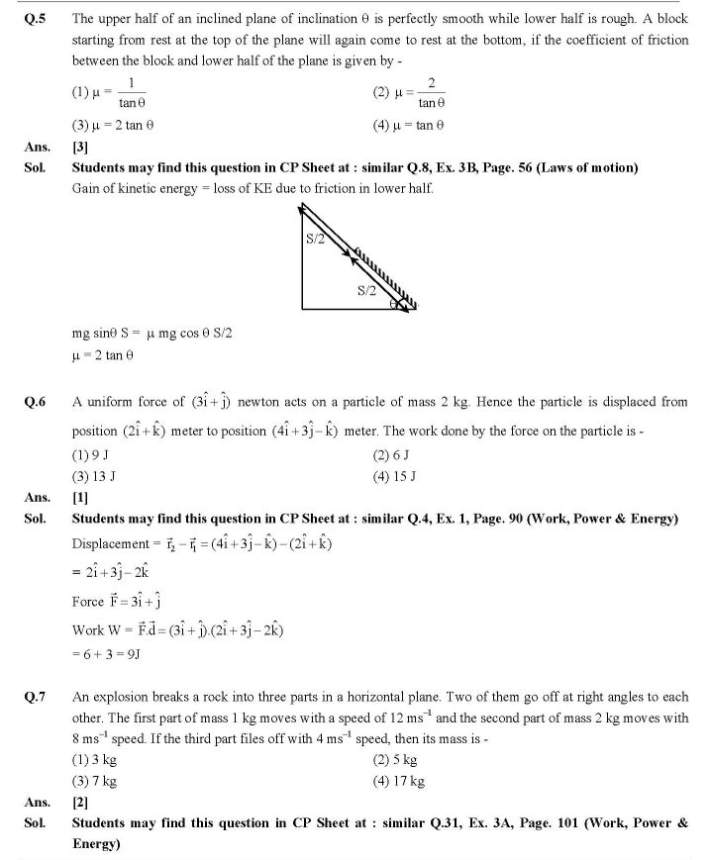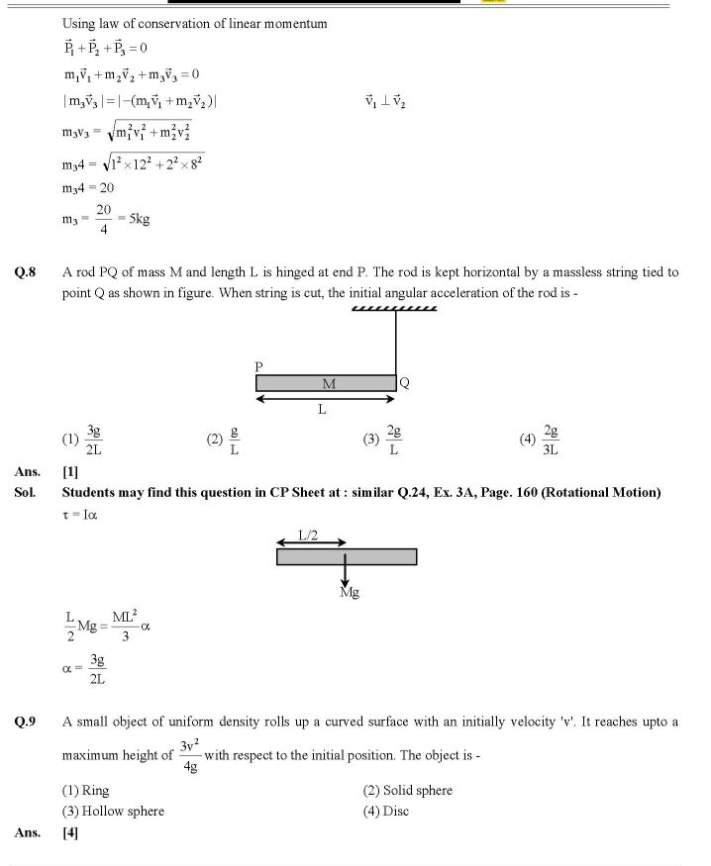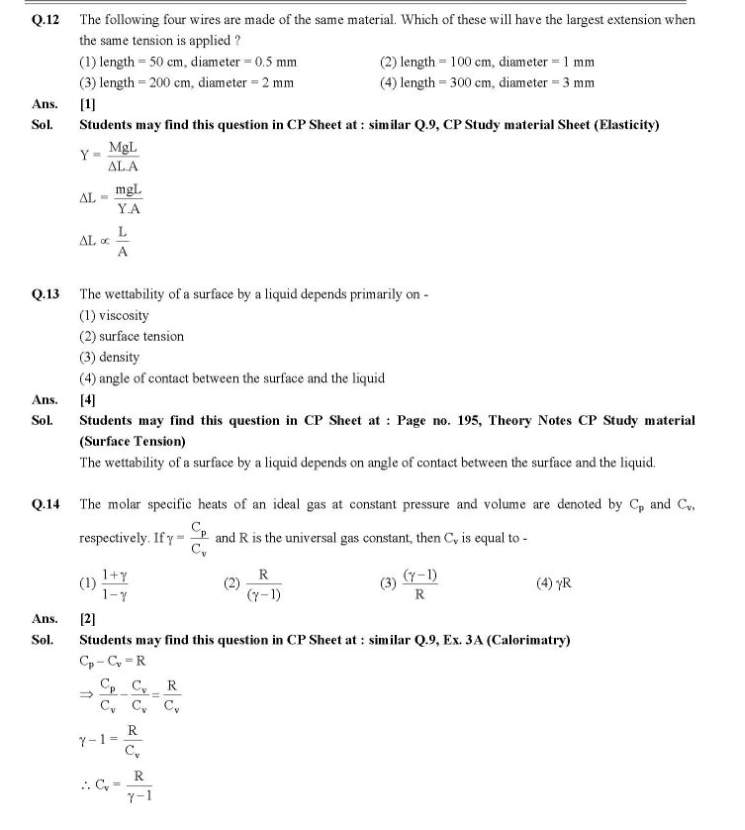| Re: In AIPMT Exam Can I Change Hindi to English Language in Question Paper
Sorry to say you but after filling exam form you cant change your language from form so next time you should be very careful while filling form.
I am giving you some questions of AIPMT exam:
Q. 1. The "Eyes" of the potato tuber are
1. Axillary buds
2. Root buds
3. Flower buds
4. Shoot buds
Sol:
Axillary buds developing at nodes/notch/eyes.
Answer: (1)
Q. 2. Organisms called Methanogens are most abundant in a
1. Hot spring
2. Sulphur rock
3. Cattle yard
4. Polluted stream
Sol:
Methanogens are archaebacteria abundant in cattle yard, and paddy fields.
Answer: (3)
Q. 3. Which one of the following have the highest number of species in nature?
1. Angiosperms
2. Fungi
3. Insects
4. Birds
Sol:
The largest phylum in animal kingdom is arthropoda, and the largest class is insecta with
7,50,000 species.
Answer: (3)
Q. 4. Archegoniophore is present in
1. Funaria
2. Marchantia
3. Chara
4. Adiantum
Sol:
Stalk bearing archegonial cluster at tip in Marchantia thallus
Answer: (2)
Q. 5. Compared with the gametophytes of the bryophytes the gametophytes of vascular
plants tend to be
1. Smaller and to have smaller sex organs
2. Smaller but to have larger sex organs
3. Larger but to have smaller sex organs
4. Larger and to haver larger sex organs
Sol:
Gametophytes are reduced and few celled in all vascular plants.
Q. 6. The gametophyte is not an independent, free-living generation in
1. Pinus
2. Polytrichum
3. Adiantum
4. Marchantia
Sol:
In gymnosperms and angiosperms gametophytes are dependent on sporophyte.
Answer: (1)
Q. 7. Important site for formation of glycoproteins and glycolipids is
1. Lysosome
2. Vacuole
3. Golgi apparatus
4. Plastid
Sol:
Golgi complex performs glycosyl transferase activity for addition of glycans on lipids
and proteins.
Answer: (3)
Q. 8.Peptide synthesis inside a cell takes place in
1. Ribosomes
2. Chloroplast
3. Mitochondria
4. Chromoplast
Sol:
Ribosomes are site of peptide bond formation.
Answer: (1)
Q. 9. In eubacteria, a cellular component that resembles eukaryotic cell is
1. Cell wall
2. Plasma membrane
3. Nucleus
4. Ribosomes
Sol:
Lipoprotein cell membrane is found in both but ribosomes are of different kinds.
Answer: (2)
Q. 10. Mutations can be induced with
1. Gamma radiations
2. Infra Red radiations
3. I A A
4. Ethylene
Sol:
Mutation can be induced with high energy radiations like UV rays, gamma rays, which
cause change in the structure of DNA.
Answer: (1) Q. 11. A collection of plants and seeds having diverse alleles of all the
genes of a crop is called
1. Genome
2. Herbarium
3. Germplasm
4. Gene library
Sol:
Germplasm can be selected as seed or plantlets for their superior traits.
Answer: (3)
Q. 12. Which one of the following also acts as a catalyst in a bacterial cell?
1. 23 sr RNA
2. 5 sr RNA
3. sn RNA
4. hn RNA
Sol:
23 S rRNA is catalytic RNA.
Answer: (1)
Q. 13. Which one of the following statements is correct?
1. Flower of tulip is a modified shoot
2. In tomato, fruit is a capsule
3. Seeds of orchids have oil-rich endosperms
4. Placentation in primose is basal
Sol:
Tomato — Berry, Orchid seed — no endosperm formation, Primrose — Free central
placentation.
Answer: (1)
Q. 14. The correct floral formula of chilli is
Sol:
Chilli belongs to Solanaceae.
Answer: (3)
Q. 15. Nitrifying bacteria
1. Reduce nitrates to free nitrogen
2. Oxidize ammonia to nitrates
3. Convert free nitrogen to nitrogen compounds
4. Convert proteins into ammonia
Sol:
Step (1) — Nitrification by Nitrosomonas
Step (2) — Nitratification by Nitrocystis
Answer: (2)
Q. 16. The function of leghaemoglobin in the root nodules of legumes is
1. Expression of nif gene
2. Inhibition of nitrogenase activity
3. Oxygen removal
4. Nodule differentiation
Sol:
LHB is O2 scavanger.
Answer: (3)
Q. 17. Which one of the following elements in plants is not remobilised?
1. Sulphur
2. Phosphorus
3. Calcium
4. Potassium
Sol:
Calcium is not remobilised, as it is a structural component in cell.
Answer: (3)
Q. 18. A drupe develops in
1. Tomato
2. Mango
3. Wheat
4. Pea
Sol:
Tomato — Berry, Wheat — Caryopsis, Pea — Legume
Answer: (2)
Q. 19. Ground tissue includes
1. All tissues internal to endodermis
2. All tissues external to endodermis
3. All tissues except epidermis and vascular bundles
4. Epidermis and cortex
Sol:
Ground tissue system includes — cortex, endoderm, pericycle and pith.
Answer: (3)
Q. 20 . In land plants the guard cells differ from other epidermal cells in having
1. Chloroplasts
2. Cytoskeleton
3. Mitochondria
4. Endoplasmic reticulum
Sol:
Guard cells are specialised chlorophyllous epidermal cells.
Answer: (1)
Q. 21. The ovary is half inferior in flowers of
1. Guava
2. Peach
3. Cucumber
4. Cotton
Sol:
Ovary is half inferior in perigynous flowers.
Answer: (2)
Q. 22. The cork cambium, cork and secondary cortex are collectively called
1. Phellem
2. Phelloderm
3. Phellogen
4. Periderm
Sol:
Phellem, phellogen and phelloderm are collectively called periderm.
Answer: (4)
Q. 23. Which one of the following is wrongly matched?
1. Cassia – Imbricate aestivation
2. Root pressure – Guttation
3. Puccinia – Smut
4. Root – Exarch protoxylem
Sol:
Puccinia — rust fungi.
Answer: (3)
Q 24. Flowers are Zygomorphic in
1. Datura
2. Mustard
3. Gulmohur
4. Tomato
Sol:
Datura, mustard and tomato have actinomorphic flowers.
Answer: (3)
Q. 25. CAM helps the plants in
1. Reproduction
2. Conserving water
3. Secondary growth
4. Disease resistance
Sol:
These are succulent plants with water storing cells.
Answer: (2)
Q. 26. Of the total incident solar radiation the proportion of PAR is
1. More than 80%
2. About 70%
3. About 60%
4. Less than 50%
Sol:
Plants capture 2-10% of PAR.
Answer: (4)
Q. 27. A prokaryotic autotrophic nitrogen fixing symbiont found in
1. Pisum
2. Alnus
3. Cycas
4. Cicer
Sol:
Anabaena cycadae is a BGA found in coralloid roots of Cycas
Answer: (3)
Q. 28. Nucellar polyembryony is reported in species of
1. Brassica
2. Citrus
3. Gossypium
4. Triticum
Sol:
Nucellus polyembryony is common in Citrus,mango and Opuntia.
Answer: (2)
Q. 29. Filiform apparatus is a characteristic feature of
1. Zygote
2. Suspensor
3. Egg
4. Synergid
Sol:
These are fingure like projections at micropylar end of synergids.
Answer: (4)
Q .30. What would be the number of chromosomes of the aleurone cells of a plant with
42 chromosomes in its roots tip cells?
1. 21
2. 42
3. 63
4. 84
Sol:
Aleurone is triploid and root tip is diploid.
Answer: (3)
Q .31. Wind pollination is common in
1. Orchids
2. Legumes
3. Lilies
4. Grasses
Sol:
Wind pollination is common in grasses and gymnosperms.
Answer: (4)
Q .32. In which one of the following pollination is autogamous?
1. Cleistogamy
2. Geitonogamy
3. Xenogamy
4. Chasmogamy
Sol:
Self pollination is favoured by cleistogamy.
Answer: (1)
Q .33. Mass of living matter at a trophic level in an area at any time is called
1. Standing state
2. Standing crop
3. Detritus
4. Humus
Sol:
Standing state represent all non-living matter in an area at a given time.
Answer: (2)
Q .34. Which one of the following statements is wrong in case of Bhopal tragedy?
1. It took place in the night of December 2/3/1984
2. Methyl Isocyanate gas leakage took place
3. Thousands of human beings died
4. Radioactive fall out engulfed Bhopal
Sol:
It was not a tragedy related to radioactivity
Answer: (4)
Q. 35. Secondary sewage treatment is mainly a
1. Biological process
2. Physical process
3. Mechanical process
4. Chemical process
Sol:
Secondary sewage treatment involves aerobic and anaerobic microbes.
Answer: (1)
Q. 36. Eutrophication is often seen in
1. Mountains
2. Deserts
3. Fresh water lakes
4. Ocean
Sol:
It is process of enrichment of lakes by phosphates, nitrates etc.
Answer: (3)
Q. 37. Large Woody Vines are more commonly found in
1. Alpine forests
2. Temperate forests
3. Mangroves
4. Tropical rainforests
Sol:
Lianas and epiphytes are more common in tropical rain forest.
Answer: (4)
Q. 38. Which one of the following expanded forms of the followings acronyms is
correct?
1. IUCN = International Union for Conservation of Nature and Natural Resources
2. IPCC = International Panel for Climate Change
3. UNEP = United Nations Environmental Policy
4. EPA = Environmental Pollution Agency
Sol:
IPCC — Intergovernmental Panel for Climate Change
Answer: (1)
Q. 39. Which one of the following statements is correct for secondary succession?
1. It is similar to primary succession except that it has a relatively fast pace
2. It begins on a bare rock
3. It occurs on a deforested site
4. It follows primary succession
Sol:
Secondary biotic succession occurs in abandoned farm lands, burned or cut forests and
lands that have been flooded.
Answer: (3)
Q. 40. Which one of the following shows maximum genetic diversity in India?
1. Mango
2. Groundnut
3. Rice
4. Maize
Sol:
Rice has more than 50,000 genetically different strains, while mango has 1000 varieties
in India.
Answer: (3)
Q. 41. Which one of the following is not a biofertilizer?
1. Mycorrhiza
2. Agrobacterium
3. Rhizobium
4. Nostoc
Sol:
Agrobacteriumis a gene transfer agent.
Answer: (2)
Q. 42. Which one of the following acts as a physiological barrier to the entry of
microorganisms in human body?
1. Skin
2. Epithelium of Urogenial tract
3. Tears
4. Monocytes
Sol:
Physiological barriers to the entry of micro-organisms in human body are tears in eyes,
saliva in mouth and HCl in stomach.
Answer: (3)
Q. 43. Which one of the following helps in absorption of phosphorus from soil by plants?
1. Anabaena
2. Glomus
3. Rhizobium
4. Frankia
Sol:
Glomus is a endomycorrhiza for phosphorus absorption.
Answer: (2)
Q. 44. 'Himgiri' developed by hybridisation and selection for disease resistance against
rust pathogens is a variety of
1. Wheat
2. Chilli
3. Maize
4. Sugarcane
Sol:
This variety is resistant against leaf and stripe rust, hill bunt.
Answer: (1)
Q. 45. Which of the followings is mainly produced by the activity of anaerobic bacteria
on sewage?
1. Marsh gas
2. Laughing gas
3. Propane
4. Mustard gas
Sol:
It is by the activity of methanogens.
Answer: (1)
Q. 46. Agarose extracted from sea weeds finds use in
1. Gel electrophoresis
2. Spectrophotometry
3. Tissue culture
4. PCR
Sol:
Agarose extracted from sea weeds finds use in gel electrophoresis.
Answer: (1)
Q. 47. Maximum number of existing transgenic animals is of
1. Pig
2. Fish
3. Mice
4. Cow
Sol:
95% of the existing transgenic animals are mice.
Answer: (3)
Q. 48. Continuous addition of sugars in 'fed batch' fermentation is done to
1. Degrade sewage
2. Produce methane
3. Obtain antibiotics
4. Purify enzymes
Sol:
Continuous addition of sugar in fed 'batch' fermentation is done to purify enzymes.
Answer: (4)
Q. 49. The process of RNA interference has been used in the development of plants
resistant to
1. Insects
2. Nematodes
3. Fungi
4. Viruses
Sol:
RNAi i.e., RNA interference is used in the development of plants resistant to nematode
like Meloidegyne incognita.
Answer: (2)
Q. 50. "Jaya" and "Ratna" developed for green revolution in India are the varieties of
1. Bajra
2. Maize
3. Rice
4. Wheat
Sol:
Jaya and Ratna are released throughout the rice growing belts of India.
Answer: (3)
Q. 51. Which one of the following organisms is not an example of eukaryotic cells
1. Amoeba proteus
2. Paramecium caudatum
3. Paramecium caudatum
4. Euglena viridis
Sol:
E. coli is a prokaryotic bacterium.
Answer: (3)
Q. 52. Which one of the following animals is correctly matched with its particular
named taxonomic category?
1. Housefly - Musca, an order
2. Tiger - Tigris, the species
3. Cuttlefish - Mollusca, a class
4. Humans - Primata, the family
Sol:
The zoological name of tiger is Panthera tigris in which Panthera is genus and tigris is
species.
Answer: (2)
Q. 53. In which one of the following the genus name, its two characters and its
class/phylum are correctly matched?
Genus name Two characters Class/ Phylum
(1) Aurelia (a) cnidoblasts
(b) Organ level of organization
Coelenterata
(2) Ascaris (a) Body segmented
(b) Males and females distinct
Annelida
(3) Salamandra (a) A tympanum represents ear
(b) Fertilization is external
Amphibia
(4) Pteropus (a) Skin possesses hair
(b) Oviparous
Amphibia
Sol:
Salamandra is a tailed amphibian, has tymphanum which represents ear.
Answer: (3)
Q. 54. Which one of the following groups of animals is correctly matched with its one
characteristic feature without even a single exception?
1. Mammalia: give birth to young ones
2. Reptilia : possess 3-chambered heart with one incompletely divided ventricle
3. Chordata : possess a mouth provided with an upper and a lower jaw
4.
Sol:
All chondrichthyes possess cartilaginous endoskeleton without exception
Answer: (4)
Q. 55. What will you look for to identify the sex of the following?
1. Male shark - Claspers borne on pelvic fins
2. Female Ascaris - Sharply curved posterior end
3. Male frog - A copulatory pad on the first digit of the hind limb
4. Female cockroach - Anal cerci
For full question paper here I am giving you one attachment:
| 




